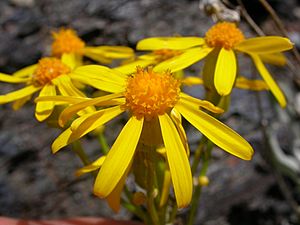Woolly groundsel facts for kids
Quick facts for kids Woolly groundsel |
|
|---|---|
 |
|
| Scientific classification | |
| Synonyms | |
|
Woolly groundsel (scientific name: Packera cana) is a type of flowering plant. It belongs to the aster family, which includes many well-known flowers like daisies and sunflowers. This plant grows naturally in western and central North America. You can find it in many different places, from flat grasslands to high mountain peaks where the weather is very cold, like an alpine climate.
Contents
What Does Woolly Groundsel Look Like?
Woolly groundsel is a perennial plant, which means it lives for more than two years. It's also an herb, so it has soft stems instead of woody ones like trees. This plant usually grows a single straight stem that can reach up to 40 centimeters (about 16 inches) tall.
Its Woolly Coat
One of the most special things about woolly groundsel is its "woolly" look. The whole plant is covered in soft, whitish hairs. This makes it feel fuzzy, almost like wool!
Leaves and Stems
The plant grows from a group of leaves at its base, called a rosette. It also has a special underground stem system called a rhizome. The leaves at the bottom are shaped like a spear or an oval. Their edges can be smooth or have small teeth. These leaves are a few centimeters long and have small stalks called petioles that connect them to the main stem. Leaves higher up on the stem are usually smaller and simpler in shape.
Flowers of Woolly Groundsel
The plant produces several groups of flowers, called flower heads. Each flower head is wrapped in fuzzy green leaves called phyllaries.
Flower Colors and Parts
Inside each flower head, you'll find many tiny, golden-yellow disc florets. These are the small, tube-shaped flowers in the center. Around the edge, there are usually 8 or 13 narrow, yellow ray florets. These are the petal-like parts that can be up to a centimeter long.
How Woolly Groundsel Reproduces
After the flowers bloom, they produce fruits. The fruit of the woolly groundsel is called an achene. It's about a centimeter long and has a fluffy top made of bristles, called a pappus. This pappus helps the seeds float away in the wind, spreading the plant to new places.

